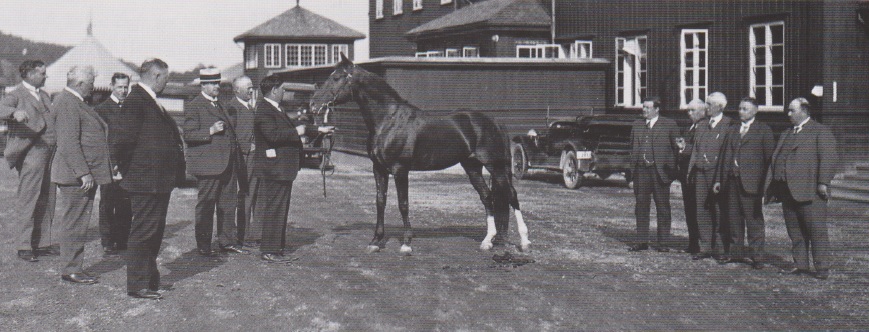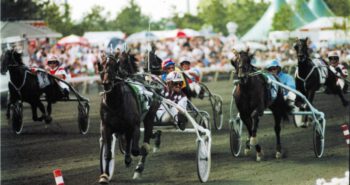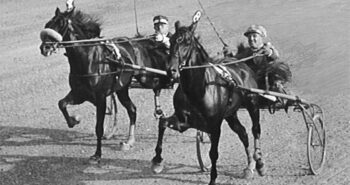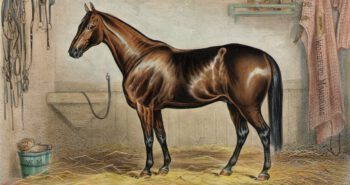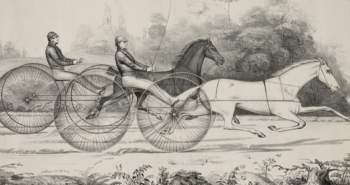The Norwegian Trotting association started to keep stallion records in 1928, and every year until 1936 the Kentucky-born chestnut stallion The Eno was the undisputed champion. However, the excellent trotter and stallion had a rough start on his career causing wanna-be comedians to suggest the horse shouldn’t be trotting but rather be touring with a circus.
The Eno was born in 1911 and from the same crop as Peter Volo and Lee Axworthy. While the former dazzled the trotting world already as a yearling, The Eno needed a little bit of time to come into his own. At 3 he showed promise, though, by taking a mark of 2:19 3/4 (1.26,9). CL “Kentuck” Floyd then purchased The Eno in late 1914 after spotting the talented 3-year-old. On finally making his Grand Circuit debut the following year the chestnut received a lot of attention – but for all the wrong reasons. At the Cranwood racetrack on Jun 29, 1915 he choked, staggered and fell through the fence after passing the half. Somehow, both the chestnut colt and the driver miraculously escaped without injuries. Three weeks later it was deja vu: The Eno seemed to be on his way to victory at North Randall when he choked down and went tumbling over the track, again. That earned The Eno the nickname “the choking horse” and some even suggested the horse should have toured with a circus. But if The Eno had some maturing to do, Floyd worked wonders with him in no time at all.
Success on the track
At the beginning of August he won a race in the 2:16 class in Detroit after winning three straight heats in 2:10 1/4, 2:09 1/4 and 2:09 3/4 (1.21, 1.20,3 and 1.20,6), respectively. He was then made the favorite in Kalamazoo a few days later, but the sloppy and heavy track bothered him and he finished in second place. Back on a dry and nice track in Grand Rapids, The Eno again won in three straight heats, this time taking his four-year-old mark 2:08 1/4 (1.19,7). The horse now had a reputation as a very speedy horse who could leave exceptionally fast and pretty much always took the lead. At the end of the year he was sold to JB Wathen of Nashville, TN but was still in Floyd’s training.
That training proved rather demanding. Prior to him starting in North Randall in July 1916 there was a longer article written on his training mile in which Floyd drove him to a 2:06 3/4 (1.18,8) clocking. He won the 2:11 class in Columbus with ease but when participating in the 2:08 class he struggled a bit, especially with the excellent Mabel Trask. He won a heat in 2:06 3/4 (1.18,8) and was timed in 2:04 3/4 (1.17,5) in another. With his new owner apparently hoping for more he was moved to Charley Valentine in August, but his new trainer couldn’t figure out the talented trotter who also suffered feet injuries. Just five months later he was again on the move to a new trainer, Ben Whitehead, but persistent injuries prevented him from starting on a regular basis. Finally in April 1920 it was announced that the trotter was sold to Europe. He spent less than two years in Denmark before being sold to Ole G Waagaard in Norway in January 1922.
“Equine Art of the highest form“
The chestnut stallion with white socks on his hind legs was a fantastic sight on the track. A contemporary Norwegian description stated that The Eno was “a wonderful horse to behold, harmonious, elegant and well-built, and it possessed lightning-fast starting abilities and maintained such pace over the first kilometer that it was just astounding. In addition, a trot so wonderful and beautiful that it, even for the most ardent anti-trotting man, had to be something of a revelation. It was not trotting in the ordinary sense. It was art, equine art of the highest form.”
The Eno was sired by The Native out of Anna B. The Native was a decent trotter with a 2:10 1/2 (1.21,1) record but his biggest claim to fame was probably that he was the full brother of Native Belle, the fantastic junior Kentucky Futurity winner and first two-year-old below 2:10 when she lowered Czarevna’s world record from 2:12 1/2 to 2:07 3/4 (from 1.22,3 to 1.19,4). The Native was a son to Moko, the outstanding Walnut Hall stallion who was affectionality known as the “Futurity stallion” since he sired numerous futurity winners.
“After Our Lord and Your Majesty”
Waagaard treated the horse’s problematic legs with care and skill and got the horse in good enough condition to win everything at the elite level in Norway, usually winning by many lengths. He lacked the strength to win over longer distances but over shorter distances he was completely untouchable. At Klosterskogen in Skien he trotted a mile in 1:29 (2:23), a fantastic time on the slow half-mile track and considerably faster than the best Norwegian horses. In the winter of 1924, the King of Norway was present during the races on the frozen ice at Frognerkilen. The king asked Waagaard if he held the horse in high esteem. The Eno’s owner Waagaard replied to King Haakon that “after Our Lord and Your Majesty there is no one I value as highly as The Eno.” – though it is unknown what Waagard’s wife thought of this statement.
Although the horse had a reputation in the US for being strong-willed, this was not visible in Norway. According to Alf Ulven, nephew of Ole G Waagaard, the horse had a unique temperament and when interviewed in the 80s still clearly remembered that “Uncle Ole” brought the horse into the living room on many occasions.
A dominant stallion
The Eno only sired 100 foal in Norway but did magnificently. His first get, the filly Nygarda, also showed extreme abilities when she raced at the ice track at Frognerkilen in Oslo in February 1925 as a fledging three-year-old. Given a 200 meter (180 yards) handicap in her debut in the race over 2000 meters (1 1/4 mile) , she nevertheless crushed all opposition and won by roughly 50 meters (45 yards) at a time of 1.40 (2:40.4), which was a sensationally good time for a Norwegian three-year-old on the ice back then. Nygarda continued her progress, but her two full-brothers Otter Eno and Eno Boy were even better. Otter Eno was dominant in the older elite for several years and also won the inaugural Scandinavian Championship in 1933. The one year younger Eno Boy was spectacularly good as a young horse and when he trotted 1.34.7 (2:32.2) as a two-year-old at Bjerke in October 1928 he was the fastest two-year-old in Scandinavia that year. Eno Boy was so dominant at 3 that he once paid 9.5 back for 10, i.e. a losing betting proposition, in one race. Needless to say, Eno Boy won that race. The Eno also sired Gerd Eno, the best filly in Norway from 1928 to 1935. He also excelled as a damsire.
The Eno passed away in 1937. Unfortunately, The Eno is forgotten now but he was obviously a great horse in his time.
The Eno
Chestnut colt born at Forks of Elhorn, KY in 1911. Died in Norway in 1937.
The Native – Anna B (John Burdine)
Fastest win: 2:06 3/4 (1.18,8) – Fastest time: 2:04 3/4 (1.17,5)
Breeder: Albert Hockensmith
Owners: Albert Hockensmith, CL “Kentuck” Floyd, JB Wathen and Ole G Waagaard
Trainers: CL “Kentuck” Floyd, Charley Valentine, Ben Whitehead and others
Drivers: CL “Kentuck” Floyd, Charley Valentine, Ben Whitehead and others
Groom: –

